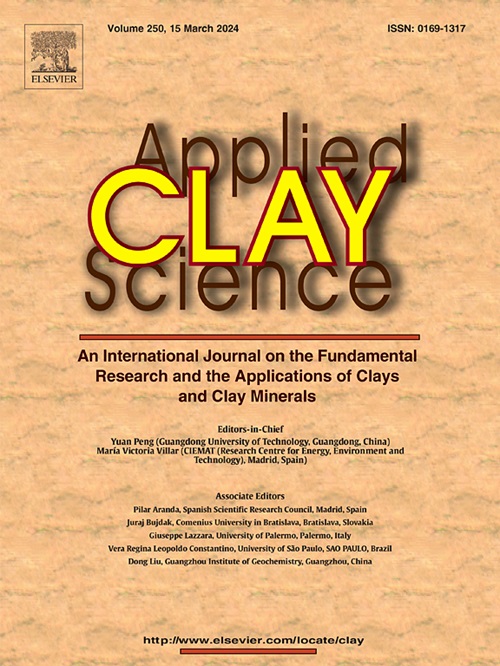Clinker-free binder based on kaolinite-rich coal gangue powder, slag, calcium carbide residue and soda desulfurization residue: Rheology, mechanical performance and hydration property
IF 5.3
2区 地球科学
Q2 CHEMISTRY, PHYSICAL
引用次数: 0
Abstract
Ordinary cement is often reported to cause high carbon emission, and it is essential to develop an ecological and high performance binder. This study introduced a new clinker-free binder performing excellent mechanical performance. Calcium carbide residue (CCR) and soda desulfurization residue (SDSR) were invited as activators, and ground granulated blast-furnace slag (GBFS) with calcined coal gangue powder (CCGP) were treated as precursors. The rheological, mechanical and hydration properties of pastes were investigated respectively. The results showed that the rheological properties of pastes fitted well with Herschel-Bulkley model and exhibited shear thinning behavior. The incorporation of CCGP increases the yield stress and inhibits shear thinning phenomenon. The compressive strengths indicated that the optimal CCGP content was 20 wt%, and its incorporation restricted hydration reaction rate and autogenous shrinkage, resulting in a denser microstructure. Metakaolin within CCGP produced typical hydration products of ettringite, C-A-S-H and N-A-S-H, and prompted hydration reaction from alkali activated materials to geopolymer cement. This study reported a clinker-free binder utilizing solid wastes and confirmed its feasibility in construction applications.
富高岭石煤矸石粉、矿渣、电石渣和碱脱硫渣的无熟料粘结剂:流变学、力学性能和水化性能
普通水泥经常被报道造成高碳排放,开发一种生态和高性能的粘结剂是必不可少的。介绍了一种机械性能优良的新型无熟料粘结剂。以电石渣(CCR)和苏打脱硫渣(SDSR)为活化剂,以煅烧煤矸石粉(CCGP)为前驱体,研究了煅烧煤矸石粉(GBFS)的煅烧效果。研究了膏体的流变性能、力学性能和水化性能。结果表明:膏体流变特性符合Herschel-Bulkley模型,表现出剪切减薄特性;CCGP的加入增加了屈服应力,抑制了剪切变薄现象。抗压强度表明,CCGP的最佳含量为20 wt%,其掺入限制了水化反应速率和自收缩,导致微观结构更致密。偏高岭土在CCGP中产生钙矾石、C-A-S-H和N-A-S-H等典型水化产物,促进碱活性材料水化反应生成地聚合物水泥。本研究报道了一种利用固体废物的无熟料粘结剂,并证实了其在建筑应用中的可行性。
本文章由计算机程序翻译,如有差异,请以英文原文为准。
求助全文
约1分钟内获得全文
求助全文
来源期刊

Applied Clay Science
地学-矿物学
CiteScore
10.30
自引率
10.70%
发文量
289
审稿时长
39 days
期刊介绍:
Applied Clay Science aims to be an international journal attracting high quality scientific papers on clays and clay minerals, including research papers, reviews, and technical notes. The journal covers typical subjects of Fundamental and Applied Clay Science such as:
• Synthesis and purification
• Structural, crystallographic and mineralogical properties of clays and clay minerals
• Thermal properties of clays and clay minerals
• Physico-chemical properties including i) surface and interface properties; ii) thermodynamic properties; iii) mechanical properties
• Interaction with water, with polar and apolar molecules
• Colloidal properties and rheology
• Adsorption, Intercalation, Ionic exchange
• Genesis and deposits of clay minerals
• Geology and geochemistry of clays
• Modification of clays and clay minerals properties by thermal and physical treatments
• Modification by chemical treatments with organic and inorganic molecules(organoclays, pillared clays)
• Modification by biological microorganisms. etc...
 求助内容:
求助内容: 应助结果提醒方式:
应助结果提醒方式:


